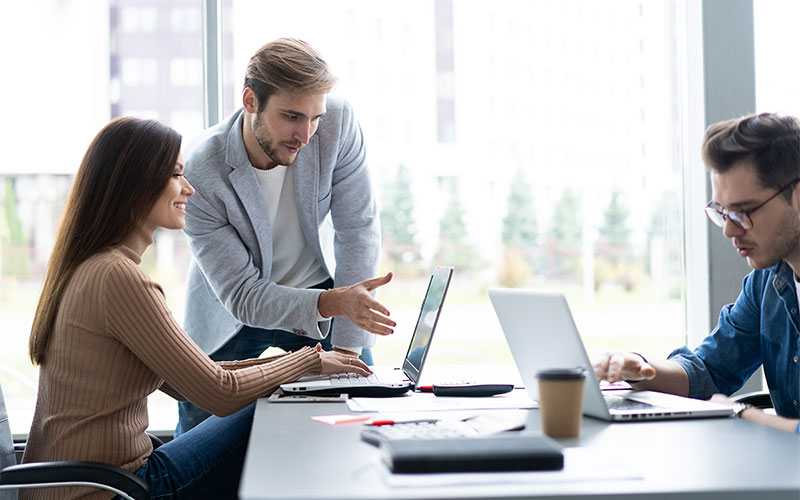
Metti al primo posto i tuoi dipendenti
Migliora l'accesso dei singoli dipendenti alle app aziendali di cui hanno bisogno, quando ne hanno bisogno, e aumenterai le prestazioni generali della tua organizzazione.
Stanno Emergendo 3 Tipologie di Aziende
(sulla base delle opinioni degli utenti finali)

Lo Spazio di Lavoro Tradizionale
I dipendenti non hanno la tecnologia di cui hanno bisogno.

Lo Spazio di Lavoro di Transizione
Le app sono disponibili, ma non facilmente accessibili.

Il Digital Workspace
Le aziende forniscono le app che i lavoratori vogliono e di cui hanno bisogno e le rendono facilmente accessibili ovunque, in qualsiasi momento e su qualsiasi dispositivo
Cinque i risultati principali
- Trasformazione digitale
- Dipendenti "empowered"
- Prestazioni migliorate
- Successo aziendale
- Allineamento
1. La trasformazione digitale sta portando ad un cambiamento nella cultura aziendale e nel nuovo ambiente di lavoro.
È quasi 3 volte più probabile che un'azienda venga classificata come leader nella Trasformazione Digitale * quando conferisce piena responsabilità ai dipendenti.
*Pionieri e leader

2. As employees become more empowered, they become more productive.
Empowered employees in firms who make apps available and highly accessible report:
- 17% less time spent on manual processes
- 16% increase in team collaboration
- 16% faster decision making

3. Making business apps highly accessible from any device powers a real difference.
Empowered employees, compared to traditional employees, are more likely by nearly:
- 5 x to report gain in personal productivity
- 4 x to report their company us a more desirable place to work
- 2 x to report that apps are very important in accelerating decision-making in the company

4. Empowered employees expect greater success at enterprise level.
Empowered employees, compared to traditional employees, project for their firms:
- 34% greater increase in effciency
- Almost 2x the increase in service quality
- HR efficiencies for recruiting (69%) and onboarding of new employees (59%)
Plus, 87% of all CIOs surveyed believe that digitally empowering their employees can drive at least 5% additional revenue growth over 3 years.

5. There is misalignment between employees and CIOs.
CIOs and employees share very different views, both in where their companies are versus peers in providing technology to employees, and about the availability, utility, and freedom to use employee technologies at work.
This indicates a degree of disappointment by employees, and a complacency in CIOs which can lead to a dangerous disconnect that may impact a firm’s performance.

It's nearly 3x more likely that a company is rated as a Digital Transformation Leader* when fully empowering employees.
*Pioneers plus leaders
Empowered employees in firms who make apps available and highly accessible report:
- 17% less time spent on manual processes
- 16% increase in team collaboration
- 16% faster decision making
Empowered employees, compared to traditional employees, are more likely by nearly:
- 5 x to report gain in personal productivity
- 4 x to report their company us a more desirable place to work
- 2 x to report that apps are very important in accelerating decision-making in the company
Empowered employees, compared to traditional employees, project for their firms:
- 34% greater increase in effciency
- Almost 2x the increase in service quality
- HR efficiencies for recruiting (69%) and onboarding of new employees (59%)
Plus, 87% of all CIOs surveyed believe that digitally empowering their employees can drive at least 5% additional revenue growth over 3 years.
CIOs and employees share very different views, both in where their companies are versus peers in providing technology to employees, and about the availability, utility, and freedom to use employee technologies at work.
This indicates a degree of disappointment by employees, and a complacency in CIOs which can lead to a dangerous disconnect that may impact a firm’s performance.
Whitepaper: Il Valore dell'Esperienza Digitale per i Dipendenti
Scopri di più su come i dipendenti guidano le organizzazioni scaricando il white paper. Esplora i principali risultati che approfondiscono l'idea di esperienza dei dipendenti, una combinazione di cultura, tecnologia e stile di lavoro influisce sull'esperienza digitale dei dipendenti stessi ed è a sua volta influenzata da quest'ultima.
Risorse aggiuntive
- Metti i dipendenti al primo posto
- Il meglio per le aziende
- Digital workspace
- Migliora l'esperienza dei dipendenti
Il motivo per cui l'IT dovrebbe mettere i dipendenti al primo posto.
Scopri come sta cambiando il rapporto tra l'IT, tradizionalmente custode della tecnologia sul posto di lavoro, e i dipendenti.

Why putting employees first is best for business.
Find compelling statistics from a host of surveyed employess across organisations. Hear what CIOs, IT teams, and end users say about the benefots of adopting new technologies in the workplace.

The 5 critical requirements for the digital workspace.
Follow this defined approach that IT leaders across organisations are taking to make a digital workspace strategy successful.

4 case studies show how IT can improve employee experiences.
Read the conclusions from these case studies on how satisfie employees drive greater productivity and business results.

Discover how the relationship between IT, traditionally the gatekeepers of workplace technology, and employees is changing.
Find compelling statistics from a host of surveyed employess across organisations. Hear what CIOs, IT teams, and end users say about the benefots of adopting new technologies in the workplace.
Follow this defined approach that IT leaders across organisations are taking to make a digital workspace strategy successful.
Read the conclusions from these case studies on how satisfie employees drive greater productivity and business results.

Principali Considerazioni a Integrazione delle Direttive sullo Smart Working per la Business Continuity
Gli eventi straordinari hanno la capacità di modificare la cultura di un'azienda molto più rapidamente di qualsiasi altra situazione. Una catastrofe naturale o una pandemia, ad esempio, impongono alle organizzazioni di rivedere o di adottare nuove tecnologie e nuovi processi di smart working per contenere i cali di produttività dei dipendenti quando decisioni personali, aziendali o governative impongono di lavorare a distanza.